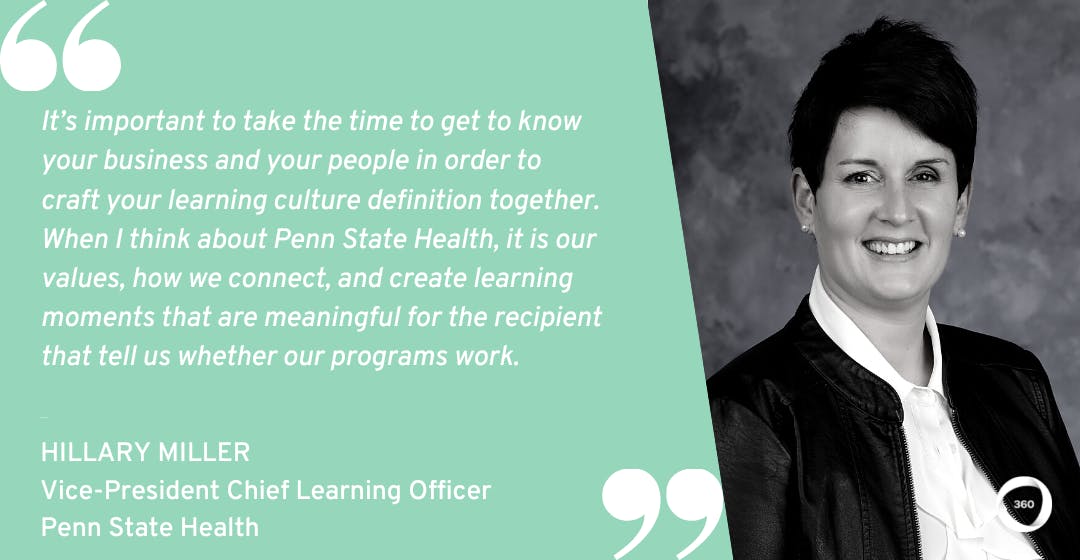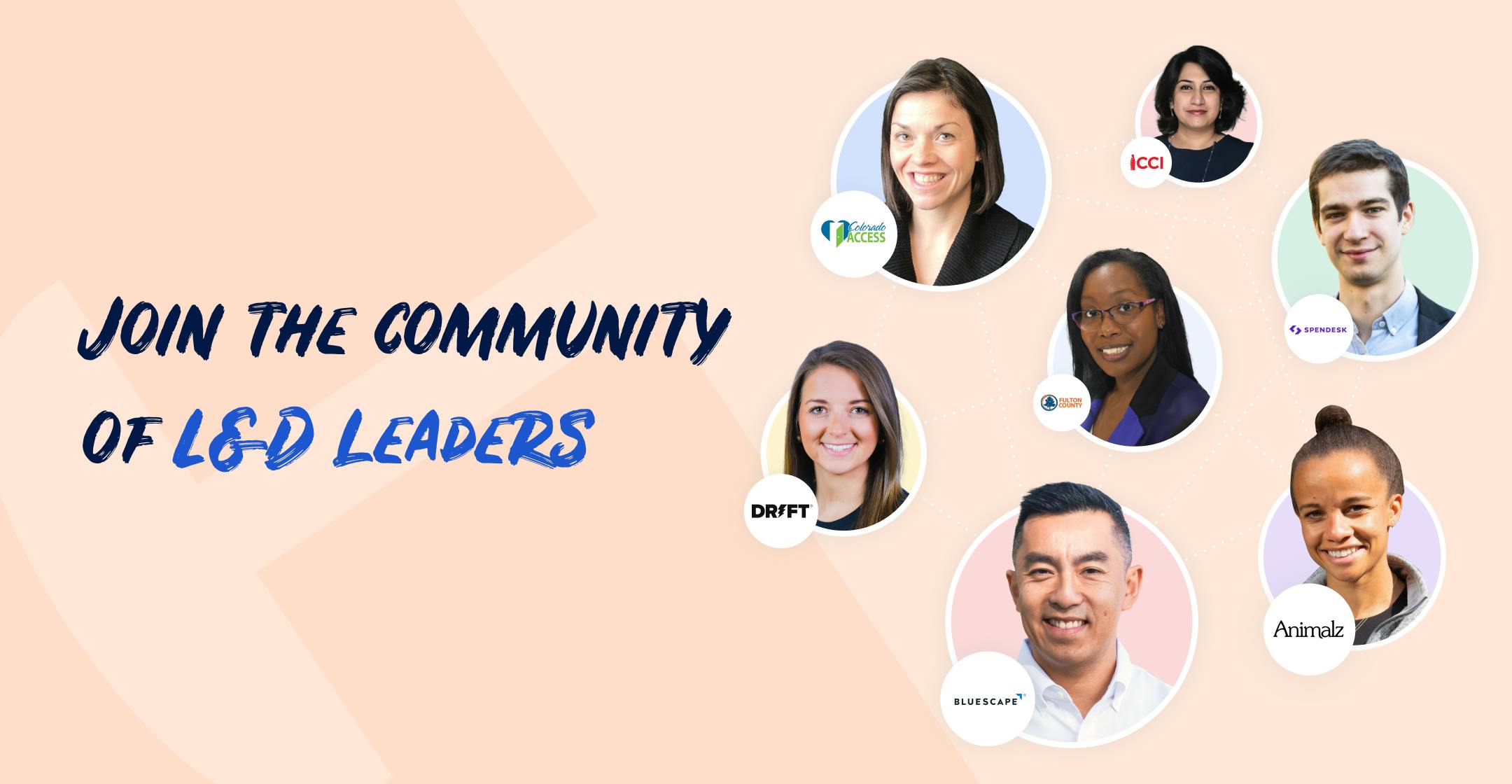As L&D leaders, we constantly try to ensure that our learning culture best fits our organization.
But are we forgetting something critical to the human experience when designing our learning strategies? And can this ‘something’ guide our leaders to help their teams in their roles while they’re doing the work?
In this interview, I speak with Hillary Miller, Vice President Chief Learning Officer at Penn State Health. Previously, Hillary was kind enough to share her 4 steps to putting experience at the heart of new hire learning. Now, she’s here to talk about how she is defining the learning culture at Penn State Health by applying empathy-guided L&D when designing learning initiatives that meet learners at their point of need.
Read on to hear how L&D is special in a healthcare system like Penn State Health.
Loving what you’re reading? Come and join the L&D Collective for more great learning insights, resources, and events!
How L&D is special at Penn State Health
Penn State Health is a healthcare system that began as an academic medical center and has now grown to include four community hospitals.
“What makes us particularly strong in the industry is that academic institution tie in but also the fact that we're able to provide healthcare services in many areas that didn't have much access previously. To me, that is really inspiring and engaging,” Hillary explains.
“When we think about learning,” she says, “we naturally have the higher education lens, but that also means partnerships across multiple areas. How do we help our employees? What's their own learning journey outside of a higher education process?”
So, what are the L&D challenges facing a healthcare system such as Penn State Health?
Looking for more expert tips? Find out how L&D leaders at Harry’s, Robert Half, Disneyland Paris and more are turning L&D into a driver of company culture.

What's company culture without L&D?
By providing your contact info, you agree to receive communications from 360Learning. You can opt-out at any time. For details, refer to our Privacy Policy.
L&D’s challenge in the healthcare sector
Industry-wide, Hillary explains, they have seen a massive change in the landscape with COVID-19 bringing other prominent challenges to the forefront.
“The main challenge is how to get people access in their moment of need. But also, how to help our leaders lead their people to manage the things they have to manage while doing the work” she says.
Healthcare's challenge is more complex because it is a highly regulated environment, focused on caring for people and their livelihoods. So for Penn State Health, it really matters that they also take care of their employees in patient care.
“When people are taken care of, they tend to take care of others, and so learning is such a huge component of any organization, but the definition of learning culture depends on the organization,” Hillary explains.
“It’s important to take the time to get to know your business and your people in order to craft your learning culture definition together,” she says. “When I think about Penn State Health, it is our values, how we connect, and create learning moments that are meaningful for the recipient that tell us whether our programs work.”

Having identified the challenges facing them, how are Hillary and her team working to make an impact? Well, it all starts with defining your learning culture.
Related: The Healthcare Industry is Facing More Challenges Than Ever–These 5 L&D Remedies Can Help
Penn State Health’s 4 initiatives to defining learning culture
In solving the challenge of helping learners in their moment of need, Hillary and her team designed four initiatives centered around empathy-guided L&D.
1. Establish an internal learning council
In facing the challenge of defining Penn State Health’s empathy-guided learning culture, Hillary and her team started an internal learning council.
“The learning council was designed to bring people around our learning management system,” she explains. “So, spending time hearing people who are in that work today matters.”
These conversations centered around how the L&D team could generate motivation around the LMS they already had. “Now that's evolved into the big bucket items that feed our strategy,” Hillary explains.
“Much of this work is around onboarding. When you think about retention and recruitment efforts, onboarding is one of the most pivotal factors, so we're addressing onboarding right now,” she says.
Penn State Health’s internal learning council highlights the benefits of upskilling from within. By connecting people who had experience with their LMS to the rest of the team, they could have conversations about how the L&D team could generate motivation around their existing system.
2. Ensure all learning fits the needs of learners
The second piece is focused on their huge student center, where folks go through their clinical training with Penn State Health.
“It matters in a healthcare system that the process works well both for the folks that are precepting and training our clinical students in addition to the students themselves in the schools that we partner with,” says Hillary.
3. Keep the process as simple as possible
The third element, as Hillary explains, comes down to being really simple in the process.
“We might have complex findings, but we do assessments, and we have quality assurance processes in place within my own team.”
4. Define your assessment processes
Finally, in Hillary's experience, it’s crucial to understand the difference between organizational development, instructional design, and facilitation.
“You might have a blend of these across team members, but how we approach organizational development changes our assessment process. We may go in and engage with a department or a unit with some culture work to do, and so, that assessment will look different than if we're building a course,” she explains.
“And when I think about how we address the challenges across our organization, it matters that our immediate education teams have the tools and resources they need to do that work.”
Related: Many Brands, One Culture: Expedia’s Peer Learning Journey
Measuring the impact of empathy-guided L&D
As she explains, Hillary and her team are well on their way to being able to measure the impact of their learning initiatives.
“Initially, it was starting with course volumes,” she says, “but course volumes only tell you that people are participating. They don’t show you the impact made in the workplace.”
“So, we are on a path to obtaining better data. Some of that is having open feedback within our on-demand courses where people rate it with stars. That's a little scary when you haven't given people that level of empowerment to say, " Gosh, can I really write this the way that I want to?’”
The second path to measuring impact focuses on how each initiative ties back to learner goals such as retention, upskilling from within and potential promotions, or a learning environment that meets their needs.
“And the third part is making paths easier for folks,” Hillary explains. “So, we get a lot of anecdotal feedback, and now we're utilizing our first-, second-, third-party data.”
First-party data: For Hillary and her team, this is their learning management system and its use cases, as well as Google Analytics and how much people click on their documents and supplemental resources.
Second-party data: Their human resources data provides points such as retention, recruitment, and exit surveys.
Third-party data: All the other information Hillary and her team have all the other information within their organization.
Tie your learning strategy to your organizational goals
In Hillary's experience, a key point for any learning leader is that your learning strategy has to be tied to the organizational goals.
“A big thing in healthcare is patient safety,” she explains. “So, how would a learning team tie into patient safety? Well, that is: what are the processes to report? What is my role in patient safety? And what reporting tools do I need to have, and how am I empowered as an individual in this organization? And frankly, why does it matter?”
“We're growing, evolving, and have a lot more work to do. But when you tie your learning goals with your organizational goals, it brings learning to the forefront rather than being seen as a department that checks off that people completed training, never to think about it again,” says Hillary.
Related: Empathy-Focused L&D: Quantum Health’s 5 Steps to Being a Successful Learning Business Partner
Empathy creates impactful L&D
In Hillary’s experience, a key impact of today's learning function is fostering empathy.
“When we're missing that self-awareness ourselves, it is tough to have patience and support for other people,” she explains. “Empathy plays a big role, not only in my personal approach but in the conversations we have with managers and leaders.”
As Hillary explains, being empathy-guided does not mean you remove any expectations or say that anyone isn’t accountable because they feel a certain way.
“But emotions are data points, and the more that we can learn to move through those and acknowledge them for what they are as not necessarily a driver for how I should behave, but rather something's hitting on this for me, I need to stop and pause and think about this. Empathy helps a leader show up in their authentic way.”
“My empathy might look different than somebody else's. That's okay. It's more important that we're actually practicing it and not necessarily showing up perfectly.”
Thanks to Hillary for sharing her insights and experience with us!
For more insights and expert advice on strategies and initiatives in L&D in the healthcare sector, check out these five L&D remedies organizations are using to face current challenges or how Maria Gentile-Feay at Quantum Health is using her five-step approach to becoming a successful learning business partner through empathy-focused L&D.
Want more peer insights on transforming workplace learning? Sign up to become a member of the L&D Collective, and check out our other #CLOConnect interviews with top L&D leaders on driving growth and scaling culture through Collaborative Learning. Or you can subscribe (below 👇) to our weekly newsletter to receive our latest posts directly in your inbox.



